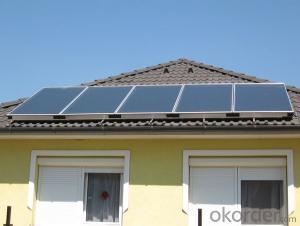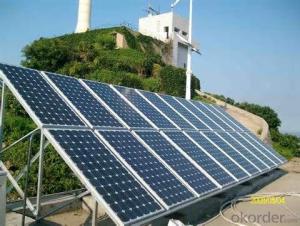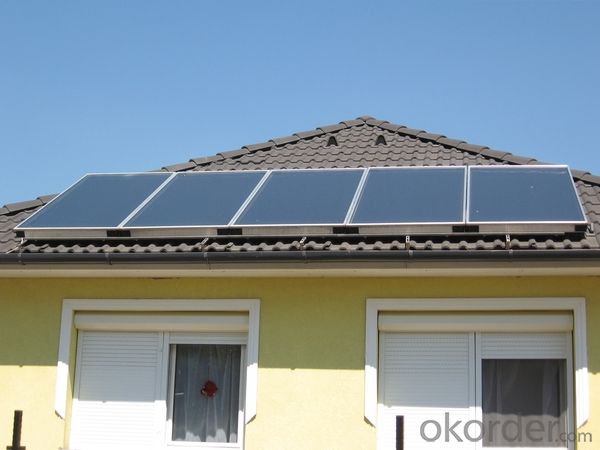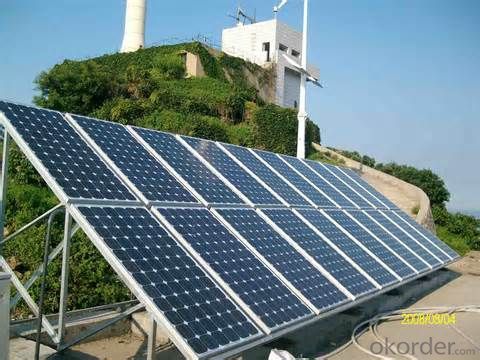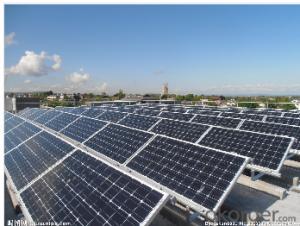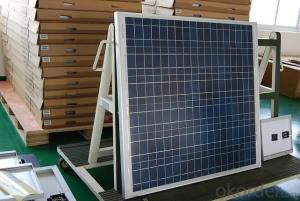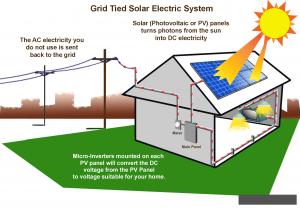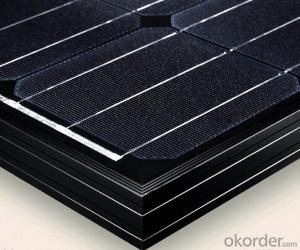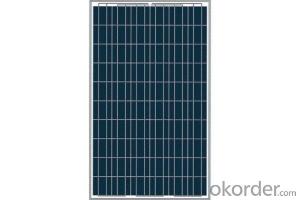Popular Polycrystalline Solar Panels 160W with High Efficiency
- Loading Port:
- China main port
- Payment Terms:
- TT OR LC
- Min Order Qty:
- 100 watt
- Supply Capability:
- 1000000 watt/month
OKorder Service Pledge
OKorder Financial Service
You Might Also Like
Specification
Introduction of Poly solar panels CNBM
Polycrystalline Solar Panels 160W With High Efficiency
CNBM Solar photovoltaic (PV) Panel is designed for large electrical power requirements. It is the optimal choice for both on-grid and off-grid power systems. CNBM Solar panel offers high performance of power per square foot of solar array. Monocrystalline silicon(c-Si): often made using the Czochralski process. Single-crystal wafer cells tend to be expensive, and because they are cut from cylindrical ingots, do not completely cover a square solar cell module without a substantial waste of refined silicon. Hence most c-Si panels have uncovered gaps at the four corners of the cells.

Feature
1.Solar Cell : High efficiency crystalline solar cell. Even if under the weak light, the solar module can produce maximum power output.
2.Tempered glass (toughened glass): Anti-reflecting coating and high transmission rate glass increase the power output and mechanical strength of solar module.
3.EVA and TPT: Using high quality EVA and TPT to prevent destroying and water.
4.Long lifetime: ≥25 years; Less power decrease.
5.Resisting moisture and etching effectively, not effected by geology.
6.The certificate issued by international authority: UL, TUV, IEC, VDE, CE.
Specification
Characteristics of Poly solar panels CNBM | |||||
Max Power Voltage Vmp(V) | 30.3 | 30.8 | 31.1 | 31.4 | 31.85 |
Max Power Current Imp(A) | 7.60 | 7.64 | 7.73 | 7.81 | 7.85 |
Open Circuit Voltage Voc(V) | 36.1 | 36.6 | 37 | 37.3 | 37.68 |
Short Circuit Current Isc(A) | 8.50 | 8.55 | 8.65 | 8.75 | 8.85 |
Max Power Pm(W) | 230W | 235W | 240W | 245W | 250W |
Temperature Coefficient of Cells Poly solar panels CNBM | |
NOCT | 45℃ ± 2℃ |
Temperature Coeffucients of Isc (%/℃) | 0.0492 |
Temperature Coeffucients of Voc (%/℃) | -0.3374 |
Temperature Coeffucients of Voc (%/℃) | -0.4677 |
Mechanical Data of Poly solar panels CNBM | |
Dimension | 1638 × 982 × 40 mm |
Weight | 19.5 kg |
No. of Cells and Connections | 60 (6 ×10) |
Tolerance | 0 ~ + 5 W |
Cell | Monocrystalline Cell 156 × 156 mm |
Packing | 624 Pcs/40ft(H) Container |
Limits of Poly solar panels CNBM | |
Operating Temperature | -40℃ to +85℃ |
Storage Temperature | -40℃ to +85℃ |
Max System Voltage | 1000VDC(IEC) / 600VDC(UL) |
Guarantees of Poly solar panels CNBM | |
Products Guarantee | 12 yrs free from defects in materials and workmanship |
Performance Guarantee | No less than 90% within 10yrs and no less than 80% within 25yrs |
Certificates | TUV(IEC61215&IEC61730),VDE(IEC61215&IEC61730),UL,CE |
Packaging Information
Package:26pcs/box
Quantity:1 box/pallent
Loading Capacity:952pcs/40ft
- Q: Can solar panels be used for charging outdoor power tools?
- Yes, solar panels can be used for charging outdoor power tools. Solar panels convert sunlight into electricity, which can be used to power various devices, including outdoor power tools such as lawnmowers, trimmers, and chainsaws. This provides a sustainable and environmentally-friendly alternative to traditional methods of charging these tools.
- Q: Do solar panels require cleaning?
- Yes, solar panels do require cleaning. Over time, dust, dirt, bird droppings, and other debris can accumulate on the surface of solar panels, which can reduce their efficiency. Regular cleaning helps to maintain optimal performance and maximize energy production.
- Q: i hav e a project for school we need to calculate cost to buy and install solar panels in our school
- It operates itself, except if there is a problem. It costs a lot to buy and setup. Some solar panels move to track the sun- the tracking equipment is complicated and needs maintenance. Some solar power systems have banks of batteries to store the energy- those wear out eventually. Some solar panels feed into the power grid, and there is a cost associated with managing that power- paid by the power company.
- Q: looking for a solar panel to charge my laptop on the road, macbook is 60 watt 6.v 3.5a, what should i be looking for in a solar panel?
- Well that's a good idea,,,here's what ya need..First you need an array that will overcome the drain effect created by the in use or sleeping laptop...that is best solved by averaging out the real use of the machine in terms of watt/minutes...If you check your transformer you'll see it has a capacity which you have cited however the true use of the computer is about 40-50 percent of that in watt/minutes..but only while your using it and when in the sleep mode the watt/minute value drops even more to about 5%.... So if your actual use consists of 2 hours of use per day at 50% and 2 hours at 5% percent the actual wattage draw is only averaged out at 34watts/minute. optimally your panel should supply all your power from its photovoltaic conversion ,but in the real world application the panel only recharges ,over a period of time, the used power. So if you had a 5 watt (@ 2vdc) panel working 480 minutes and used up 35 x2=700 and 9 x2=8 for a total of 78 watts you would have 5 x 480 = 7200 watts input and a parasitic load of 78 watts in the two hours...well within the recharge state required.. For a little safety I would permanently wire a cigarette lighter type plug to the end of the panel this will keep the polarity correct and serve as a quick disconnet means...Also add a fuse at .5 amp... a good place to get these are on the internet....some are very expensive some a very cheap --go for a middle of the roader...Have a good one from the E...
- Q: A local air conditioning company is advertising combining their (newly installed) central air conditioning system for homes, with roof solar panels. They say that the combination MAY reduce your electric bill. Nothing I can see to back-up their claims. Hmmmmm. And they offer, if you can get it; central air conditioning that runs on natural gas. Again, possibly cheaper than using electricity.Has any one actually tested to find out if solar panels and/or natural gas DOES, or DOES NOT save you any money to make it worth the bother?
- Solar okorder /
- Q: I want to build solar panels for my house.Dose anyone try okorder is this really work?
- you okorder they have solar panels
- Q: Can solar panels be installed on a rental property?
- Yes, solar panels can be installed on a rental property. However, it is important to check with the property owner or landlord before proceeding with the installation. Some landlords may have specific policies or restrictions regarding modifications to the property, so it is necessary to obtain their permission and potentially negotiate the terms of the installation.
- Q: Dear Friends, I am very much worried about Global warming, So to contribute something for reducing Global Warming I have decided to use Solar Panels. Can anybody tell me what is the price of these Solar Panels and why people are not using them when they are environment friendly. What are the Pros and Cons of these Solar Panels?
- here's lot of articles about the questions you just asked about solar panels, enjoy renewableenergyarticles.blogspot....
- Q: There are so many solar panels and kits it is very confusing. I need to know what exactly I would need if I had an underground home with no electricity. I want to be totally off the grid with solar power. Someone please explain to me in simple terms what exactly I need. Maybe give me a link to the right kit for me. Also are they easy to install? Are there instructions that I need to download?Thank you
- Homemade okorder /
- Q: How hard is it to install solar energy panels on your house? Is this a reasonable way to produce 00% of your house's energy? Is there any danger?
- Hi okorder
Send your message to us
Popular Polycrystalline Solar Panels 160W with High Efficiency
- Loading Port:
- China main port
- Payment Terms:
- TT OR LC
- Min Order Qty:
- 100 watt
- Supply Capability:
- 1000000 watt/month
OKorder Service Pledge
OKorder Financial Service
Similar products
Hot products
Hot Searches
Related keywords
